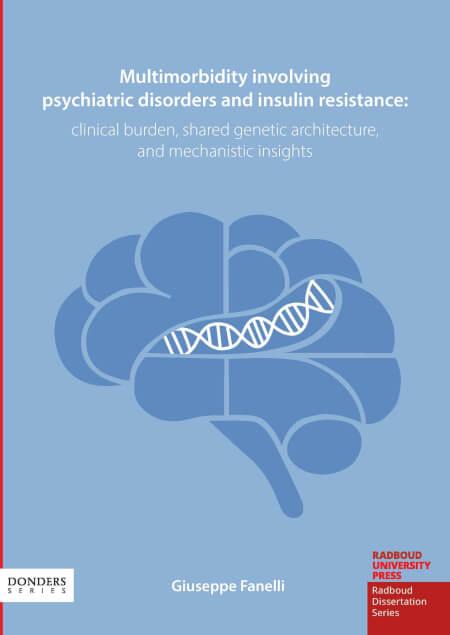Multimorbidity involving psychiatric disorders and insulin resistance: Clinical burden, shared genetic architecture, and mechanistic insights
Keywords:
psychiatric genomics, insulin resistance, multimorbidity, genome-wide association study, transcriptomicsSynopsis
Psychiatric disorders are prevalent mental health conditions that frequently co-occur with insulin resistance (IR)-related somatic conditions, like obesity, type 2 diabetes mellitus (T2DM), and metabolic syndrome (MetS). Although lifestyle factors and pharmacotherapeutic side effects have long been posited as the principal mechanisms underlying such multimorbidity, accumulating evidence indicates that intrinsic dysregulation of insulin signalling in the central nervous system may also play a role. The overarching aim of this thesis is to clarify how IR-related metabolic conditions intersect with psychiatric disorders from both clinical and genetic standpoints. By integrating epidemiological research, primary care data, and large-scale genomic analyses, this work uncovers how IR-related conditions shape clinical trajectories of psychiatric disorders and share essential molecular mechanisms with them. Two central parts delineate this effort, beginning with in-depth clinical and phenotypic perspectives on psychiatric-IR multimorbidity (Part I) and advancing to its underlying genetic architecture and molecular mechanisms (Part II).
PART I: Clinical and phenotypic interfaces of psychiatric–insulin resistance multimorbidity (Chapters 2–4)
Part I provides a clinical and phenotypic framework for understanding how IR adversely influences cognitive function, risk for mood disorders, and treatment outcomes in depression. Chapter 2 systematically reviews empirical findings from the UK Biobank, focusing on the relationship between IR-related conditions and cognition. A pronounced negative impact on multiple cognitive domains—including reasoning ability and processing speed—emerges among individuals with IR-related conditions, suggesting that IR might exacerbate cognitive deficits commonly associated with psychiatric disorders. Chapter 3 evaluates the bidirectional link between T2DM and mood disorders, integrating both evidence from longitudinal studies and Mendelian randomisation analyses. The results demonstrate that T2DM confers a more severe depressive course, whereas mood disorders in turn accelerate cardiovascular and metabolic complications in T2DM, likely through inflammatory and hypothalamic–pituitary–adrenal axis dysregulation. Chapter 4 leverages primary care records from the UK Biobank to address how concurrent IR conditions influence the clinical profile, antidepressant treatment response, and overall management of depression. Participants with IR-related comorbidities exhibit delayed improvement under antidepressants and require more complex pharmacological regimens, underscoring that metabolic disturbances not only potentiate morbidity but also hinder therapeutic success.
PART II: Genetic architecture and molecular mechanisms of psychiatric–insulin resistance multimorbidity (Chapters 5–7)
Part II shifts toward the genetic and molecular dimensions of psychiatric–IR multimorbidity, employing state-of-the-art genomic approaches to pinpoint shared biological pathways. Chapter 5 investigates genome-wide association studies (GWAS) to explore genetic correlations between psychiatric disorders and IR-related conditions. These analyses reveal a spectrum of genetic relationships, with some disorders—such as major depressive disorder and ADHD—exhibiting positive genetic correlations with IR conditions and traits, while others, including anorexia nervosa and obsessive-compulsive disorder, demonstrate negative correlations. Chapter 6 further dissects these relationships through local genetic correlation analyses across semi-independent genomic regions, highlighting specific loci with pleiotropic effects. Even in the absence of global genetic correlations for some disorders (e.g., bipolar disorder or Alzheimer’s disease), shared regions implicate biological pathways related to immune-inflammatory responses, insulin receptor recycling, and lipid metabolism. Chapter 7 synthesises this understanding through genomic and transcriptome-wide structural equation modelling, uncovering a latent multimorbidity factor capturing shared genetic liability across psychiatric and IR-related phenotypes. This factor implicates pathways related to insulin binding, Notch signalling, and immune-inflammatory regulation, with tissue-specific gene expression analyses highlighting roles for the cerebellum, cortex, and pituitary gland. These findings point toward early neurodevelopmental and endocrine mechanisms underlying the observed multimorbidity. Drug repurposing analyses identify potential therapeutic candidates, including memantine and rosiglitazone, which target intersecting neuroprotective, metabolic, and immune mechanisms.
CONCLUSION
The collective results from Chapters 2–7 clarify that IR-related conditions substantially worsen psychiatric outcomes, including poorer cognition, heightened symptom severity, and suboptimal treatment response. Beyond clinical implications, genomic analyses confirm that psychiatric disorders and somatic insulinopathies converge on shared loci and pathways—including insulin signalling, immune responses, and vesicle-mediated synaptic regulation—highlighting a convergence that was not fully appreciated through earlier, single-phenotype approaches. These findings endorse the view that certain neuropsychiatric disorders can be fruitfully reconceptualised as “insulinopathies of the brain”, where potentially central insulin signalling deficits amplify risk or severity. The perspective that metabolic and psychiatric pathologies are mutually reinforcing, with a partial common genomic basis, stimulates new strategies for prevention and care. Interventions targeting both metabolic health and psychiatric stability—ranging from lifestyle modifications to immunomodulatory and insulin-sensitising agents—appear promising. Future investigations should verify these candidate pathways through experimental models, expand sampling to multi-ethnic cohorts, and systematically evaluate drug repurposing options. Ultimately, this thesis contributes a cohesive framework for understanding and mitigating the burden of psychiatric–IR multimorbidity in the era of precision medicine.

Published
Series
Categories
License

This work is licensed under a Creative Commons Attribution-NonCommercial-NoDerivatives 4.0 International License.

